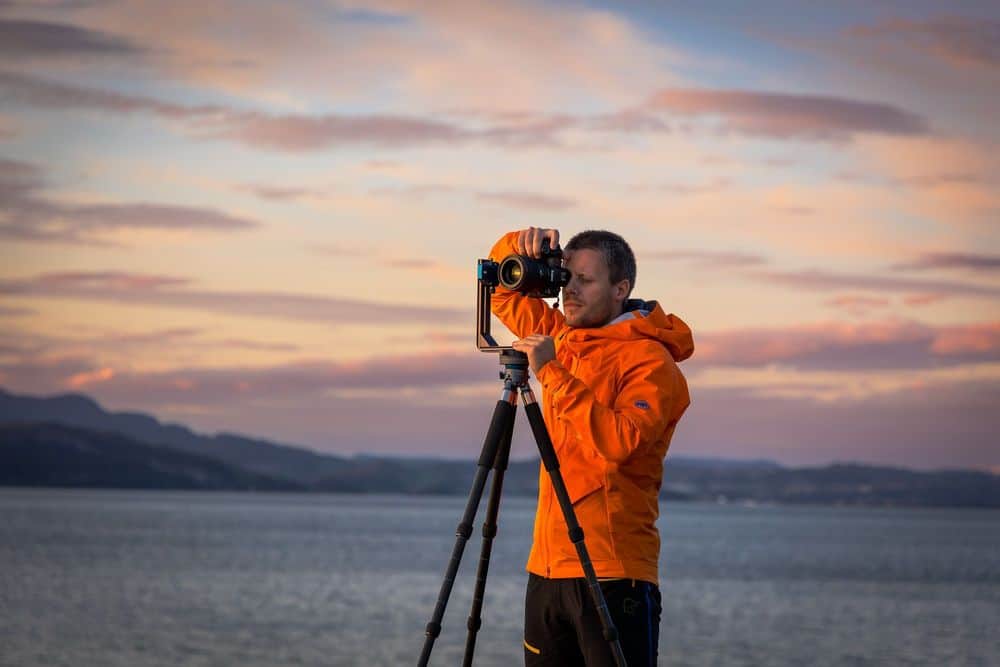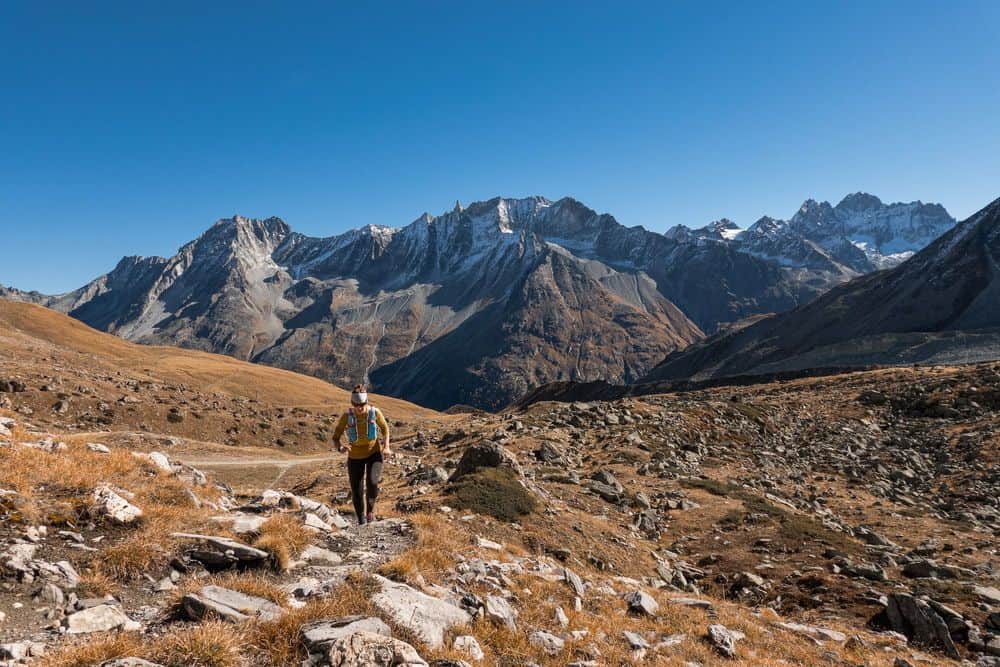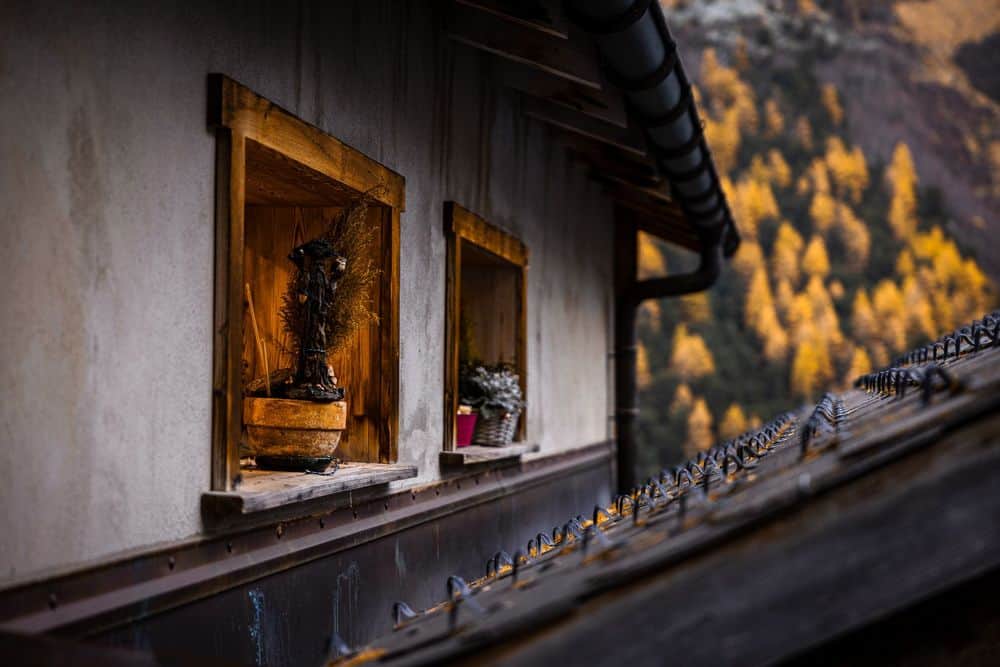Golden larches in the Engadin. If you want your website to rank for this keyword on Google, you have to make quite an effort. Anyone who has ever been able to visit the autumnal, golden larch forests in Engadin or Valais will immediately understand why. These two Swiss cantons, in particular, are known in autumn for their sweeping valleys and mountain slopes lined with brilliant golden larch forests.
But instead of many words to describe the intense colors during the Engadin autumn season, it’s probably better to just let a picture do the talking.

In this article we would like to give an overview for autumn lovers and photo enthusiasts who want to get information about the Engadin larches and learn more about good photo locations, some planning and equipment tips and the Engadin in autumn in general.
The Engadin
In the Swiss Alps, you’ll find larches mainly in the rather dry high valleys and high altitudes in Engadin and Valais. The Engadin in particular, located at an altitude of up to 1800 meters in the south of Graubünden, has gained a reputation for its ideal location and every year in autumn the density of photographers around the well-known spots increases massively – with all its advantages and disadvantages.
Extensive mountain forests full of larches spread out around the idyllic high valley. In the valleys, deep blue lakes such as the Lej Silvaplana or high alpine mountain and glacier landscapes provide an impressive backdrop, above all the high mountain basin around the easternmost 4000-meter peak in the Alps, the famous Piz Bernina.
Thanks to its excellent public transport connections, including the Rhaetian Railway, reaching photo spots in any direction is as easy as can be. Often you can take the ecological route and leave your car behind. The infrastructure for electric cars is also well developed in the Engadin. From 22 kW charging points to fast chargers to a Tesla Supercharger in St. Moritz, the selection of charging stations is large, some of which can even be found in remote parking lots.
Many places can also be reached very easily by mountain bike, thanks to the well-developed trail network. Here, only the heavy backpack on the back could put a spoke in the photographer’s wheel, which is not always pleasant on the bike. However, those who take on this effort can also reach their destination by fair means.
The choice of accommodation is not a problem in the Engadin as a distinct tourist destination, especially in the much less busy autumn weeks. Between high-priced luxury hotels and vacation apartments in every level of equipment to several modern campsites, everyone will find what they are looking for, although some hotels are even closed in the off-season.
Our photography workshops
Gain the knowledge of an internationally acclaimed photographer and transform your images into real eye-catchers. In our workshops, you will learn how to fully exploit your potential.
Discover all workshopsThe best season: autumn equals larch season
Spring, summer, autumn and winter: each season has its own character. One likes the warmer temperatures in the summer months better than the dark autumn and winter days, the other appreciates exactly this cold season all the more and is happy about the snow and icy winter days.
If one were to record this preference in a survey of photographers, the result would probably show a strong tendency towards autumn. The reason is simple: a low sun with often good lighting conditions, beautiful colors and thanks to the late sunrise and early sunset, you do not have to torture yourself out of bed at impossible times to catch the morning light. And in the evening, there is still time for a relaxing evening program after sunset. Sounds good, doesn’t it?
The best time of year to admire the “Swiss Indian Summers” is from about the beginning of October until November. However, the exact period also depends strongly on the weather conditions. Due to the high altitude of almost 2000 meters above sea level, it can get very cold even in autumn in the Engadin. Not infrequently, the first snow has already fallen in the course of October and requires appropriate clothing, especially if you want to be out and about in the mountains. Frequent strong winds and a lot of precipitation can shorten the larch period, whereas sunny, dry autumn weeks can keep the colorfulness even well into November.
In addition, the effects of global warming on the vegetation are increasing, because the summer months, which are now regularly too hot and therefore too dry, are also leading to an earlier onset of needle fall. By the end of October/beginning of November, it can already be too late and the larches have already lost a large part of their colorfulness.
The typical season for hiking is already over by this time. The cows have left the Alps and have long since been herded back down into the valley. For those who, in addition to photography, are also keen on smaller and larger hikes, the huge network of hiking trails in the Engadin now offers an ideal period to enjoy the impressive mountain world more or less alone. Those who would like to discover the alpine fauna have a good chance of finding what they are looking for in autumn and running into a herd of ibex.
With sometimes icy temperatures, you should always keep an eye on the conditions in the mountains, because passages with snow or even ice can certainly occur at higher altitudes at this time of year. If the equipment is not appropriate, this can quickly lead to problems and in the worst case even to the abandonment of the tour.
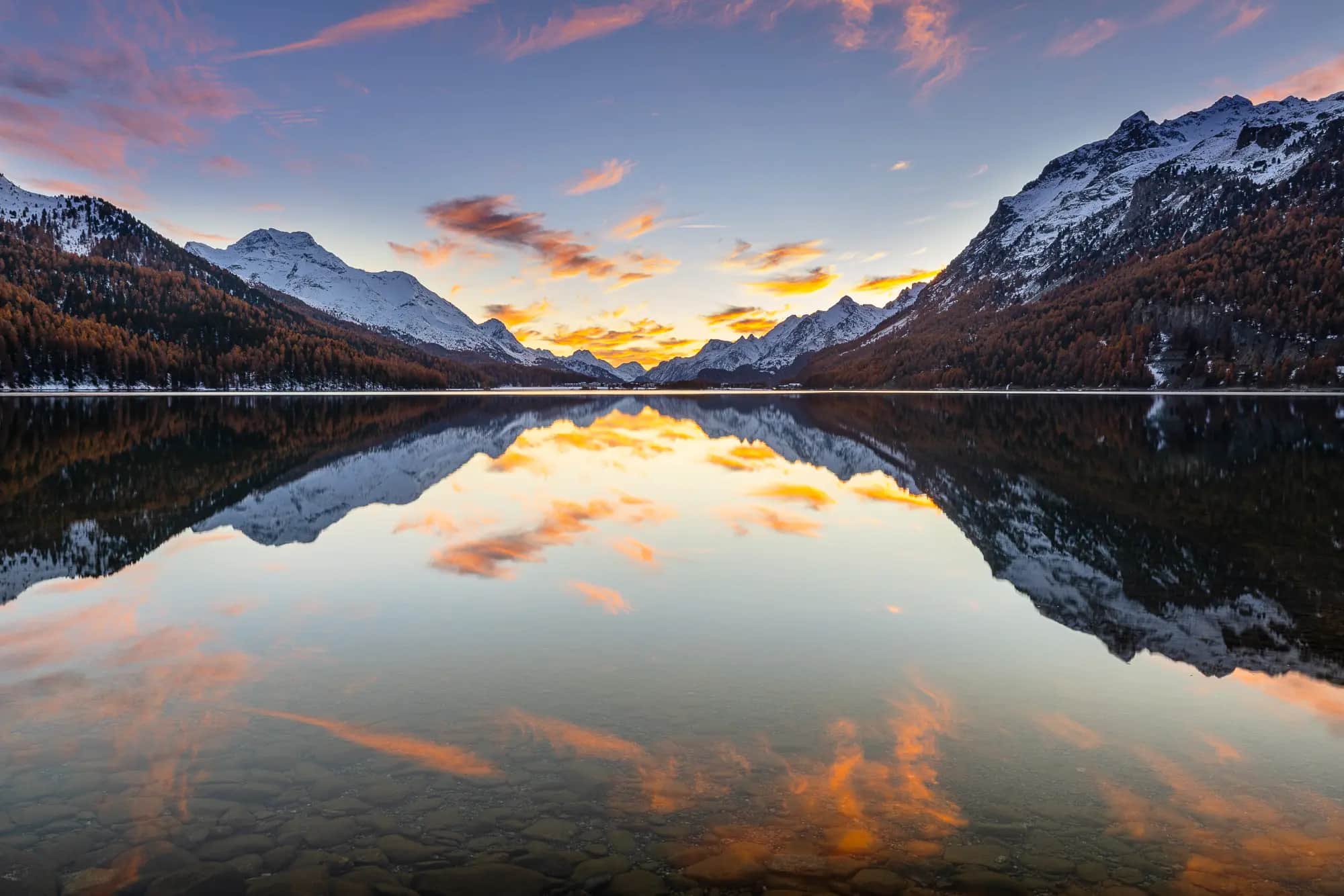
Some facts
Larches (christened in Latin with the sonorous name Larix) belong to the pine family, but they are a little special because, unlike many other European conifers, they lose their needles in the fall. Before they do, what we all know from any deciduous forest happens: the leaves (or in the case of larches, their needles) change color, wither, and then fall to the ground.
Before they fall and form a soft, carpet-like and spicy-smelling forest floor, they do camera-savvy people a special favor in combination with warm, autumnal sunlight and glow for some time in a rich yellow hue that varies between orange and golden yellow. Everyone can easily imagine what a harmonious combination the bright blue sky, impressive mountains, the first white snow and golden-yellow larches make – the complementary colors send their regards.
Larches often reach a lifespan of more than 50 years. Its wood is mainly used in construction and furniture making, because it is a very hard species. As firewood, however, it plays only a minor role.
Pure Spots.
Fine art prints from this location.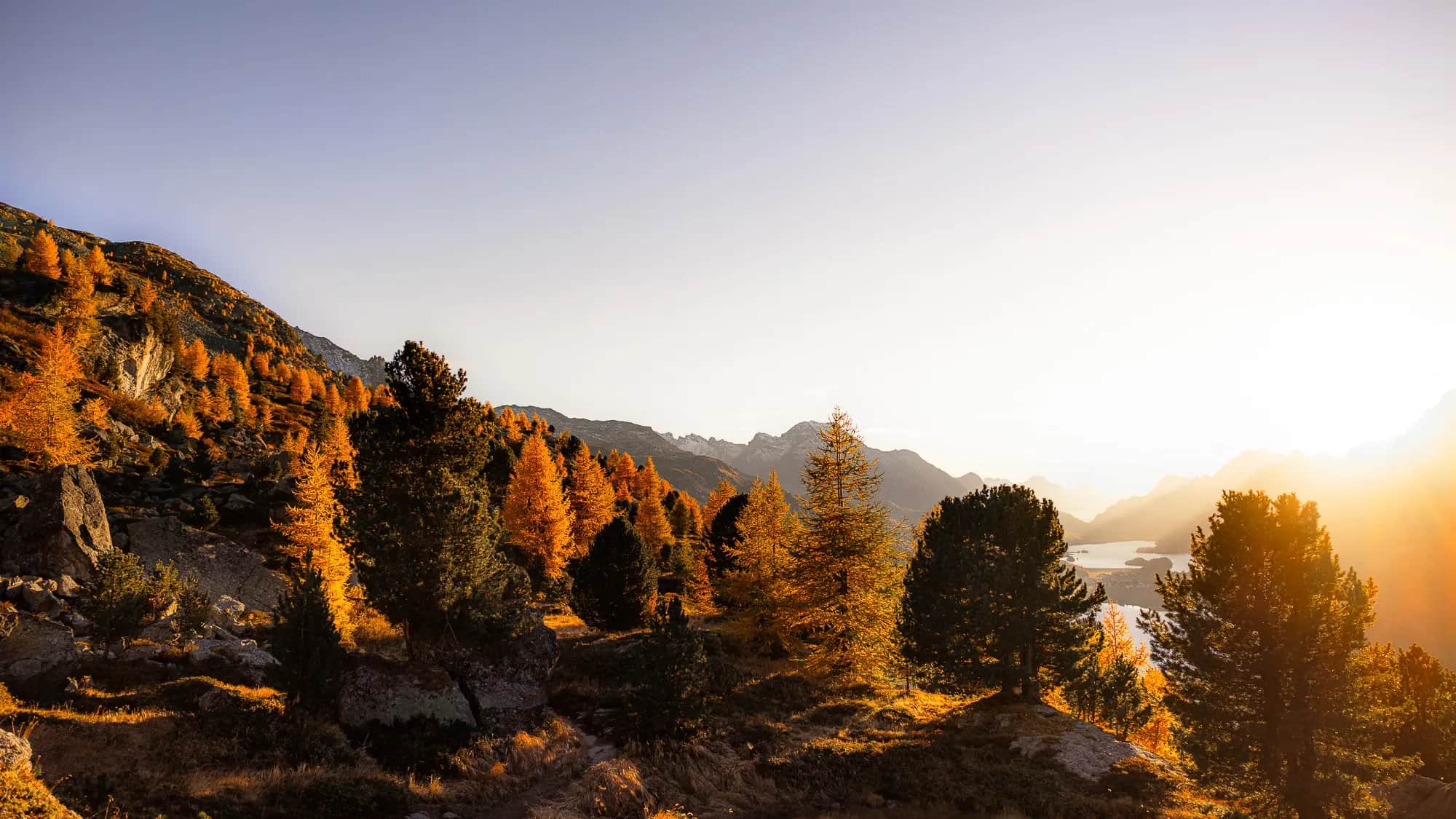
What you (as a photographer) should have with you
Further above I have already mentioned the very cold temperatures depending on the weather, sometimes in combination with wind, snow or rain. Warm, waterproof and windproof outdoor clothing should therefore be present for all extended tours, including appropriate footwear of course.
While suitable clothing should be a matter of course, another piece of equipment may require a separate mention: the headlamp. Since the days are short and certainly no one wants to descend into the valley in the dark and cold after a long evening with full focus on photography, a good headlamp with sufficient power is an absolute must.
Also enough to eat and drink, maybe in a thermos bottle (especially if you want to wait somewhere up there for the perfect light), can make the stay in the Engadin mountains more pleasant.
And last but not least, a small emergency kit should not be missing on all longer (photo) tours, consisting of a bivy sack and a first aid pack. The combination of a heavy photo backpack and descent in the dark can otherwise become an unpleasant adventure more quickly than one would wish, even with a twisted ankle.
Especially for photographers who want to capture the unique landscape and the glowing larches in the Engadin in all conceivable situations, I also recommend the following photo equipment:
- A stable and at the same time light tripod with which you can also climb a few meters in altitude – especially important to be able to take photos with long exposures at one of the numerous lakes and rivers.
- ND filters (also called gray filters) are a good tool, especially during the day, for taking long exposures on a tripod despite the bright lighting conditions. Two to three different strengths often make sense, since the possible exposure time depends on this.
- A polarizing filter can bring out even more color intensity from the images under the right lighting conditions. Although you should not simply use it all the time in front of the lens, it can prove to be a useful tool in combination with sunlight that is as perpendicular to you as possible.
- And for the frostbite, I can warmly recommend heat insoles and heat pads for the gloves, so to speak – especially if you have to wait longer for the perfect lighting conditions, these little helpers can make the waiting time more pleasant. However, since these are unfortunately often disposable items, you should not overdo it with their use.
It is more difficult to make concrete recommendations for the camera and lens, since anything between a super-telephoto lens and a wide-angle lens can be used. More important at this point is certainly sufficient memory in the camera and possibly one or two additional batteries, since this comes through cold and wind faster than usual to its limits.
As is so often the case, however, when photographing autumn larches: it’s not the equipment that produces the results, but what you can do with the equipment you have.
The most famous photo spots for larches in Engadin
If you are interested in photographing larches in the Engadin, you have surely come across tons of pictures of the well-known and unfortunately often hopelessly overcrowded (hot) spots. As is so often the case, these are usually the locations that are relatively easy to reach with little effort. Here you probably won’t find the unique, never-before-seen motif, but nevertheless these places naturally also have their charm and inspire the visitor with great sceneries.
The Lej da Staz
First and foremost (because it’s the easiest and completely uncomplicated to reach) is the Lej da Staz near St. Moritz, which is an ideal subject thanks to the surrounding larch forests and relatively wind-protected location. Unfortunately, you’ll never have this place to yourself and by now the biggest challenge is not so much to get a good photo, but to get a good photo without a dozen other photographers in the picture. With many visitors, unfortunately, the usual problems like trash lying around also increase, which is why I think the Lej da Staz is now rather suitable only for an incidental snapshot. But especially in light morning fog the scenery is quite beautiful and if you don’t mind a certain amount of foot traffic, it’s definitely an interesting place.
The Val Roseg
The Val Roseg is another highlight and fortunately completely car-free. Only horse-drawn carriages and bicycles are allowed to tackle the unpaved road to the Hotel Roseg. In addition to this main path, there are a number of smaller hiking trails that lead idyllically through dense to sparse larch forests. Within two to three hours you can find many beautiful motifs in Val Roseg and the valley (especially in the back part after Hotel Roseg) is by far not as crowded as the not far away Laj da Staz or the better known Val Morteratsch to the east. Those who venture into the back part of the valley enter the high alpine world of the Roseg glacier, the Piz Roseg as well as the imposing west face of the Piz Bernina.
The Val Morteratsch
Anyone who has already taken the Rhaetian Railway to the Bernina Pass knows the stunning view directly after the train station and hotel Morteratsch into the valley of the same name, the Val Morteratsch. The glacier trail leads directly from the station into the valley in about an hour and after only a few minutes the view of the Bernina area with Piz Cambrena, Piz Palü, Bellavista, Piz Bernina and Piz Morteratsch opens up. The ice masses of Vadret Morteratsch, which have suffered greatly from global warming, are still imposing to look at today and form an ice-blue contrast to the sparse larch forests that line this unique high valley. Here, too, you will rarely be alone, but with a bit of intuition and ingenuity you can find unknown perspectives and spots that you can enjoy on your own.
The Lägh da Cavloc
A little further south in the Engadin, the small Lägh da Cavloc in the narrow high valley is a popular spot from Maloja. Here, too, you will usually share the spot with many others, but due to the approximately one-hour climb, at least a certain amount of effort is required to reach the small lake at an altitude of a good 1900 meters. If you have your mountain bike with you anyway and don’t mind a good 100 meters of altitude gain with your photo backpack on your back, you can save quite a bit of time here, especially on the way back, and roll back comfortably on the well-maintained road.
The Lake Sils
Probably the most famous photo of Lake Sils in the midst of supposedly untouched nature, bursting with larch forests, adorns every tourism magazine with the theme “Engadin in autumn”. The lake lies idyllically in the middle of the landscape, on the horizon the snow-covered mountains stretch into the sky and a small peninsula juts out into the lake. In this photo, the camera positioning matters a lot, because it is important to block out the many features of civilization (for example, the cantonal road to the Maloja Pass that passes just a few meters below the photo location).
So if you like to take the typical photo of Engadin autumn in a sea of luminous larches, you should go to this spot on the southeast flank of Piz Lagrev.
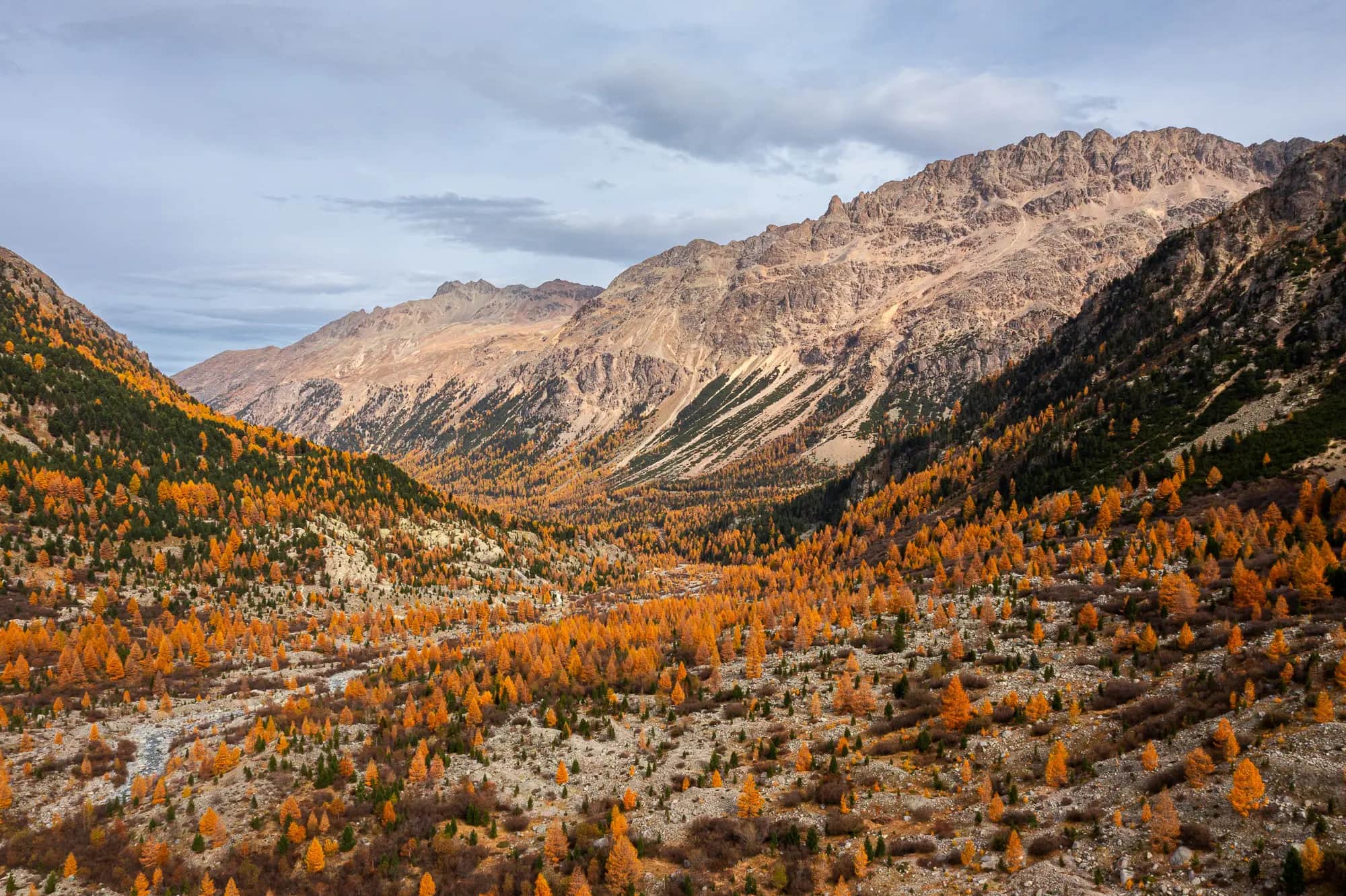
Discover photo spots off the mainstream
When Marina and I are on the road with our cameras, we always try to leave the familiar perspectives and find our own, individual ways for landscape photography. For this, we also accept longer tours and climbs that take us to new and little-visited places, which, due to the optimal light conditions in the morning and evening, is not infrequently also associated with a very early ascent or a return in the dark.
The vastness of the Engadin with its countless small side valleys, a dense and well-marked network of hiking trails and the overwhelming views that often extend in many directions make it quite easy to leave the beaten track and discover new motifs on our own. In addition to the location, however, experience has shown that a completely different factor plays a more decisive role: the right light. With low, golden sunlight, it is often possible to create an interesting motif even with the most boring mountain slopes. If ingredients such as light fog or clouds in the sky are added to give the scene depth, there’s really nothing standing in the way of successful landscape photography.
But how can you best discover and plan for such more remote photo spots?
Too much planning is often not effective
In my opinion, the most important thing is to also allow for a certain surprise factor. Too much planning often leads to a “cerebral” approach, which can be rather frustrating with the amount of unplannable factors such as light conditions, weather, wind and one’s own physical condition (anyone who has ever run into a hunger pang after a long climb and was no longer able to do anything but eat knows what I’m talking about). You try all the time to do everything right and according to your planning, but nature is not impressed by this in the least.
If the basic factors are right and you feel a particular location might be photographically worthwhile, then it may be best to just go for it and give it a try. Often great opportunities arise on location and not so seldom chance plays a role and enables photos in the form of sudden windows of sunlight or swathes of fog that could not have been planned at all – which makes them unique at the same time.
Use topographic maps
Start with a look at the map. Especially in Switzerland we have the invaluable advantage of access to excellent map material (which is unfortunately not the case in most other countries). Official hiking trails (even currently closed ones) can be shown and hidden, giving a good understanding of the accessibility of peaks, valleys, rivers or lakes.
Search elements for an interesting image composition
The latter is a good keyword: try to consider whether there are locations where you could include a body of water in your motifs. Don’t think too much about how exactly the composition might look like – reality will throw a spanner in the works anyway, for example in the form of small waves that make reflections impossible or a murky water consistency because until recently cows grazed at this lake. By the way, even the smallest puddle of only a few square meters of water surface can be used – here, for example, reflections are often even the easiest to put into practice.
In addition to rivers and lakes, striking mountain backdrops in the background can also play a decisive role in successful image composition. In the Engadin, of course, the Bernina massif is particularly suitable for this, but other striking mountain shapes such as Piz Julier, Piz Lagrev or the massif of Piz Kesch can also be integrated into image compositions.
For these considerations, tools such as Google’s image search can also be helpful in order to get an approximate picture of the conditions on site based on existing photos from the Internet.
Consider the sunlight
The best location is of little use if the light is simply not right. On the one hand, this can happen when the sun simply doesn’t shine due to clouds. Or it disappears behind other mountains and your location is in the shade.
For a basic consideration, the terrain topography plays an important role in sunlight. For example, is your planned location in a narrow valley running north to south and you want to shoot in the golden hour? In that case, you’ll probably have trouble seeing sunlight at all, because the sun disappears too quickly behind the western ridges.
For considerations like this, topographic maps and apps like PhotoPills can help you get an accurate understanding of where the sun or even the moon is at what time.
Plan enough time
In autumn the days are short, but the ascents in the Engadin are logically not shortened. On the contrary: if you are hiking with a heavy photo backpack and, in addition to your camera and lenses, you also have a tripod and all the other equipment with you, the ascent can take a little longer than usual and be strenuous.
After you have climbed more than 1000 meters in altitude for your photo location, you should also plan time for breaks and preparation on site. Putting on warmer clothes, eating and drinking, setting up a tripod with clammy fingers or mounting a panorama system: all these activities take time and it is more than unpleasant if you have to watch the sunlight fading and are only ready when the best light mood is already over.
If we want to photograph at higher altitudes and have a corresponding ascent ahead of us, we therefore always set off so that we have rather an hour of waiting time on location. We can then use this time for preparation, mostly also for a bit of freezing – or for a change of location if the planned location turns out to be unsuitable.
Excursion: how we discover new photo spots
We have already written about the most important steps for discovering alternative photo locations in our article: work with a map and apps for photography planning, look for potentially exciting elements for the image composition and still don’t spend too much time on theoretical considerations, but in case of doubt just go for it.
With the help of an example, I want to show our considerations exemplarily, which have led to the following photo.
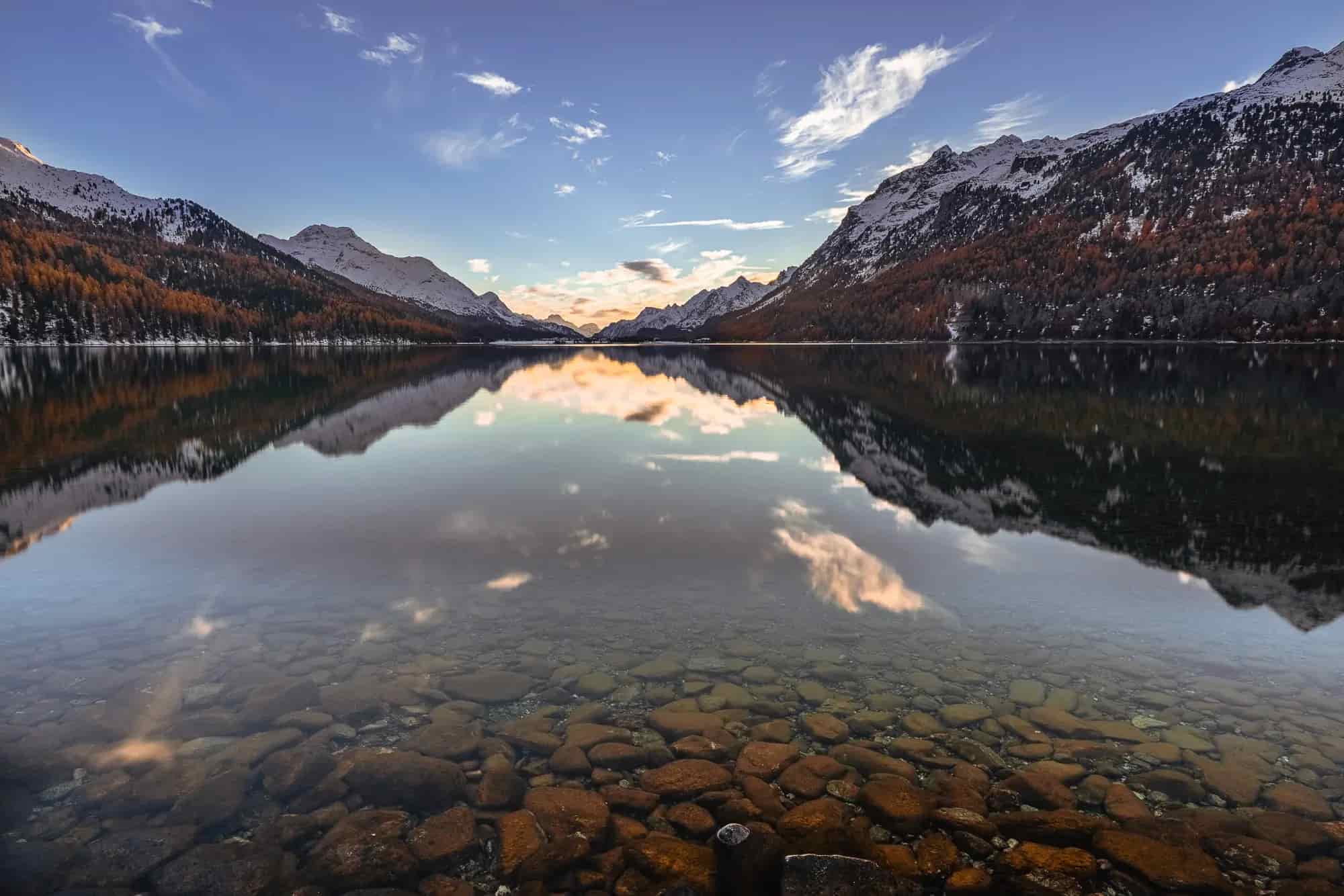
This picture was taken in the Engadin at Lake Silvaplana. The basic consideration for this image was to use the reflection of the snow-covered mountain slopes and larch forests in the lake as the core motif. At the same time, I wanted to combine this part of the motif with the upcoming sunset, which will happen approximately at the intersection of the end of the valley, and use the last light and colors of the setting sun.
Already during the day we saw the snow-covered and larch-lined mountain slopes and one could roughly imagine how they would look in the last light of the day and be reflected in the hopefully calm Silvaplana Lake. A quick check in the PhotoPills app revealed that the sun should have completely disappeared behind the mountains at about 6pm on this last day of October, making for a beautiful sky coloration. Checking the weather report gave the green light and a look at the sky showed some small clouds, which played an important role in the final picture later.
On location, it was then just a matter of finding a suitable spot on the shore, but that was no problem with a short ten-minute walk. By the way, we were all alone during the whole time for this photo. The rocks dropping into the water in the shore area turned out to be an additional little treat that wasn’t planned at all. With a polarizing filter to avoid the reflections, the stones merging into the water surface could be perfectly integrated into the scene.
A bit of luck also played a role, of course, because the lake was completely calm and there was almost no wind. This could have otherwise ruined the scene quite a bit.
By the way, you can find the final picture further up in this article: it was taken a few minutes later, when the setting sun illuminated the clouds drifting in the sky from below and these in turn were reflected in the lake.
And in bad weather?
If the weather is really bad, you should simply accept that as both a mountaineer and an outdoor photographer. Of course, the more easily accessible photo spots can also be visited in rain or snowfall, but you should not expect miracles from such lighting conditions.
Alternatively, the Engadin offers the great advantage of being very extensive. Besides the foothills in the south over the Bernina Pass to Poschiavo and west from Maloja down to Chiavenna, the Engadin is also divided into the Upper and Lower Engadin. While it is easy to tend to consider only the Upper Engadin around St. Moritz and Pontresina, the regions around Zernez and Scuol should not be forgotten. When visiting the Lower Engadin, we are already 30-40 kilometers away from St. Moritz, which can make the difference between a snowstorm or sunshine. Not to forget the Swiss National Park in the Engadin, which spreads from Zernez towards Val Müstair to the east, also covered by larches and offering untouched nature en masse.
In all the regions listed, as an attentive visitor you can find countless shining larches and many far less frequently frequented and photographed photo locations, which are often in no way inferior to the well-known locations around St. Moritz.

Photographing larches in the Engadin – is it worth it?
Fact is: if you like to discover autumnal colors in combination with high, snow-covered mountains in an indescribably beautiful nature, you should not miss a visit to the Engadin in autumn at the time of the golden larches. Despite a certain density of people with cameras, with a little effort it is possible to find new and less frequented places that sometimes even outrank the well-known hotspots.
The good accessibility of all these locations contributes to the fact that one can enjoy the time in the Upper or Lower Engadin. The many potential photo motifs also comfort you in cool temperatures over clammy fingers and cold feet, if the photo shoot takes longer and the good light just won’t stop.
Do you have any questions or would you like more information? Feel free to write us in the comments or get in touch with us. In individual photo workshops we also like to give you an introduction to the interesting and more remote regions of the Engadin and take you to unknown and exciting photo spots in this unique region in the south of Switzerland.





